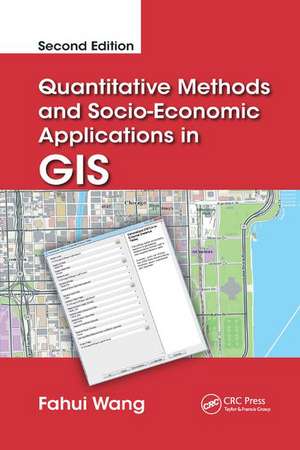Quantitative Methods and Socio-Economic Applications in GIS
Autor Fahui Wangen Limba Engleză Paperback – 2 aug 2017
See What’s New in the Second Edition:
- All project instructions are in ArcGIS 10.2 using geodatabase datasets
- New chapters on regionalization methods and Monte Carlo simulation
- Popular tasks automated as a convenient toolkit: Huff Model, 2SFCA accessibility measure, regionalization, Garin-Lowry model, and Monte Carlo based spatial simulation
- Advanced tasks now implemented in user-friendly programs or ArcGIS: centrality indices, wasteful commuting measure, p-median problem, and traffic simulation
The book illustrates the range of computational methods and covers common tasks and major issues encountered in a spatial environment. It provides a platform for learning technical skills and quantitative methods in the context of addressing real-world problems, giving you instant access to the tools to resolve major socio-economic issues.
Preț: 548.35 lei
Preț vechi: 596.03 lei
-8% Nou
Puncte Express: 823
Preț estimativ în valută:
104.92€ • 109.85$ • 86.82£
104.92€ • 109.85$ • 86.82£
Carte tipărită la comandă
Livrare economică 07-21 aprilie
Preluare comenzi: 021 569.72.76
Specificații
ISBN-13: 9781138843622
ISBN-10: 1138843628
Pagini: 334
Dimensiuni: 156 x 234 x 18 mm
Greutate: 1 kg
Ediția:Nouă
Editura: CRC Press
Colecția CRC Press
ISBN-10: 1138843628
Pagini: 334
Dimensiuni: 156 x 234 x 18 mm
Greutate: 1 kg
Ediția:Nouă
Editura: CRC Press
Colecția CRC Press
Public țintă
Academic and Professional Practice & DevelopmentCuprins
PART I. GIS AND BASIC SPATIAL ANALYSIS TASKS. Chapter 1. Getting Started with ArcGIS: Data Management and Basic Spatial Analysis Tools. Chapter 2. Measuring Distances and Time. Chapter 3. Spatial Smoothing and Spatial Interpolation. PART II. BASIC QUANTITATIVE METHODS AND APPLICATIONS. Chapter 4. GIS-Based Trade Area Analysis and Applications in Business Geography. Chapter 5. GIS-Based Measures of Spatial Accessibility and Application in Examining Healthcare Access. Chapter 6. Function Fittings by Regressions and Application in Analyzing Urban and Regional Density Patterns. Chapter 7. Principal Components, Factor Analysis and Cluster Analysis and Application in Social Area Analysis. PART III. ADVANCED QUANTITATIVE METHODS AND APPLICATIONS. Chapter 8. Geographic Approaches to the Small Population Problem and Application in Cancer Data Analysis. Chapter 9. Spatial Statistics Analysis and Applications in Toponymical and Crime Studies. Chapter 10. Linear Programming and Applications in Examining Wasteful Commuting and Allocating Healthcare Providers. Chapter 10. Linear Programming and Applications in Examining Wasteful Commuting and Allocating Healthcare Providers. Chapter 12. The Cellular Automata Model and Application in Simulating Urban Growth. Chapter 12. The Cellular Automata Model and Application in Simulating Urban Growth. Reference. Index.
Recenzii
"The volume continues to provide a valuable steer towards the use of spatial computational techniques to address problems in different social policy contexts and one that includes material that could easily form the basis of applied spatial statistics modules at range of learning levels." - Gary Higgs, University of South Wales, Pontypridd
Descriere
The second edition of a bestseller, this book details applications of quantitative methods in social science, planning, and public policy with a focus on spatial perspectives. Updated to include the most recent version of ArcGIS 10.1, the new edition also covers recent developments in GIS—for example, simulation of urban environment. Two new chapters highlight cellular automata-based simulation of urban growth and Monte Carlo simulation of urban traffic, each co-authored with leading experts in the respective fields. In addition, all discussion has been expanded to improve readability, particularly for students.
